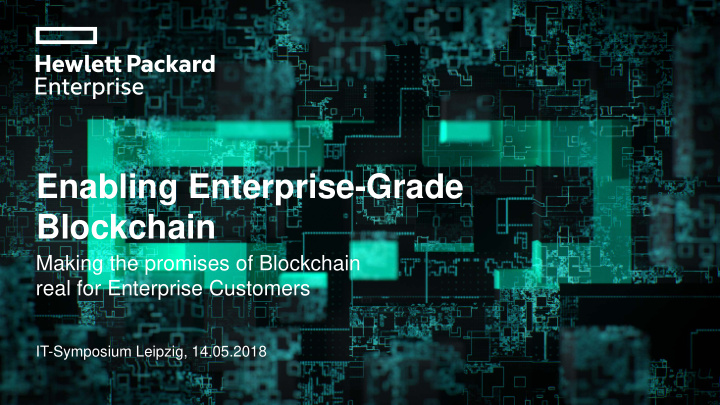



Enabling Enterprise-Grade Blockchain Making the promises of Blockchain real for Enterprise Customers IT-Symposium Leipzig, 14.05.2018
Agenda Introduction participants & expectations of participants Rainer Maaß 14:00 – 14:15 Blockchain & Distributed Ledger Technology Marcus Friedrich 14:15 – 15:00 fundamentals Industry challenges & use case discovery Matt Lennie 15:00 – 15:45 Break 15:45 – 16:00 Presentation R3 Corda Blockchain Platform Simone Blair 16:00 – 17:00 Applying R3 Corda on HPE NonStop to solve industry Simone Blair and 17:00 – 18:00 challenges Matt Lennie
Blockchain & Distributed Ledger Technology fundamentals 3
Blockchain technology will create significant business value Trust Total business value generated Improved to exceed $176B between un-trusted parties regulatory reporting reduces need for trusted by 2025 1 in compliance increases stakeholders and intermediaries record transparency and ease of auditability $20B New products per year reduction in & services Automation infrastructure costs by 2022 2 streamlines business VCs and Banks have allocated due to Blockchain processes across entities, 40% of all fintech investments building a secure value in Blockchain startups 3 transfer system 1 Gartner – “Forecast Blockchain Business Value, Worldwide 2017-2030” (2 March 2017) 2 Santander InnoVentures – “Santander: Blockchain Tech Can Save Banks $20 Billion a Year (5 Jul 2015) 4 3 CB Insights – “Blockchain Investment Trends in Review” (2017)
Intermediaries exist today to provide trust & establish identities Benefits of Intermediaries Challenges of Intermediaries – Establish trust – Centralized – Verify identities – Vulnerable to attack or failure – Provide security & prevent fraud – Higher-cost – Reconciliation – Slow, incremental change – Process transactions – Lack of transparency makes governance of contracts harder – Keep records Intermediaries Financial brokers Governments/ Corporations Regulators 5
Blockchain Technology: Building Blocks Asymmetric Cryptography Consensus Mechanism Proof of Work Proof of Authority Proof of Stake Peer-to-Peer Networking Cryptographic Hash Functions 6
Why is it called a Blockchain? Block of confirmed & valid Block 1 Header Block 2 Header transactions Block header hash Block header hash Block of potential double spend transactions Previous block Previous block header hash header hash Block of unconfirmed transaction requests Nonce Nonce Merkle Root Merkle Root Block 1 Transactions Block 2 Transactions Time 7
Blockchain Ecosystem User & Developer Exchange Node & Miner Wallet Node 8
Blockchain vs. Distributed Ledger Blockchain Distributed Ledger - Network of unknown participants - Network of known & authorized participants - Consensus: Proof of Work / Proof of Stake - Consensus: Proof of Authority - Trust enforced through Blockchain protocol - Trust enforced through restricted access - Use case: Non trusted Transactions - Use case: Disintermediate backend processes Centralization Decentralization 9
Use cases for Blockchain & Distributed Ledger Business Model Products & Services Business Operations • • Funding Workflow & processes • • • Ownership & liability Enable IOT for transactions Data sharing & integrity • • • Stakeholder governance Turn products into assets Embedded security • • • Customer interaction Instant services consumption Privacy protocols • • • Revenue / Profit / Risk Self-governing machines Notarization • • Token economy Auditability & immutability Create VALUE Increase REVENUE Reduce COST Distributed Ledger Blockchain 10
The Token Classification Framework Underlying Utility Legal Status Technical Layer Purpose Value Where does the On which system What utility does What is the tokens What is the token’s token derive its layer is the token the token provide? legal status? main purpose? value from? implemented ? Asset-backed Blockchain-Native Usage Tokens Utility Tokens Cryptocurrencies Tokens Tokens Network Value Non-native Work Tokens Security Tokens Network Tokens Tokens Protocol Tokens Investment Hybrid Tokens Cryptocurrencies Share-like Tokens d(App) Tokens Tokens 11
Decision tree Do you need Are there Can you use Are all yes yes no no Permissionless to store multiple an always writers Blockchain state? writers? online TTP? known? yes no no yes Are all Is public Public no yes writers verifiability Permissioned trusted? required? Blockchain yes no Private Permissioned Blockchain Don‘t use Blockchain Source: „Do you need a Blockchain?“, https://eprint.iacr.org/2017/375.pdf 12
HPE Pointnext services help you on your Blockchain journey Explore Experiment Evolve HPE Blockchain Transformation HPE Blockchain Platform Assessment HPE Blockchain Implementation to get Workshop is a one-day interactive session and HPE Blockchain Proof-of Value will you up and running with your blockchain designed to help customers understanding gather and validate your use cases, solution: design & implement production- blockchain outcomes and challenges, align demonstrate technology capabilities and ready system, manage change and train to a vision and strategy and identify best use provide a proof-of-value for select use case teams and help you evolve for additional cases and technologies use cases Partnerships support full integration of blockchain solutions 13
Security Considerations 14
Supply Chain Track & trace across the extended value chain Corporate Finance Distributor Customer B C A Decentralized peer-to-peer network D F E Manufacturer Partner Distributor Benefits Provenance & history of the entire bill- More effective governance of service Greater efficiency of planning and – – – of-materials on a shared, trusted platform level objectives across all elements of execution in large & complex supply the supply chain chains Self-auditing with traceable “chain-of- – custody” for every item Highly scalable with multi-party Greater insights on demand for – – relationships forecasting and predictability 15
Mission Critical Distributed Ledger Technology (DLT) Integration of R3 Corda and HPE’s Mission Critical NonStop platform Available as-a-service and on premise Designed specifically to address the functional and non-functional requirements of enterprise customers R3 Corda is meeting functional requirements An enterprise ready solution powers for decentralized business models HPE’s Mission Critical technology − Record, manage and synchronize nodes − Resilient and linear scalability + − Contracts between trading partners − Integrated fault-tolerant SQL/MX database − Uses distributed ledgers − Highly secure platform − Privacy matters – data is shared only between − Empowered by HPE Pointnext services parties who need to know 16
Recommend
More recommend